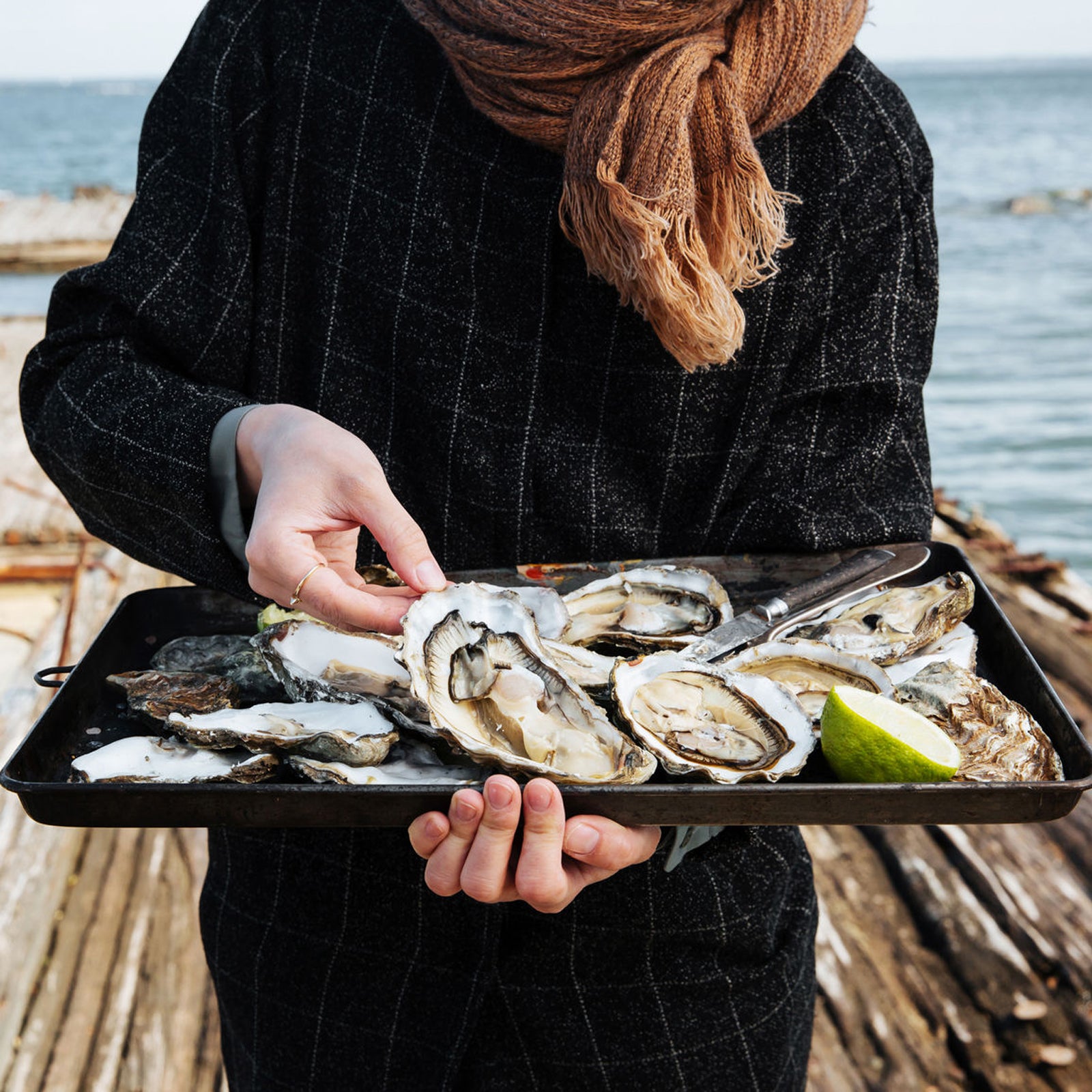Captain Chris Ludford puts his table right in the water. I’m using the word “table” loosely here—it’s a bunch of metal oyster cages stacked on top of each other, with a stained piece of wood on top. His guests stand around this table, wearing fisherman waders and rubber boots while Ludford shucks them oysters, one after the other, each pulled from the Lynnhaven River��in eastern Virginia, the same water they’re all standing in. This is the culminating event of Ludford’s farm tour, where guests spend an afternoon learning about the history of oysters in the Chesapeake Bay and see firsthand how he��grows them��in cages in the brackish waters. But eating these oysters, shucked by the man who grows them himself, is easily the highlight of the tour.
“It’s like I’ve got a raw bar��right there on the water,” Ludford says. “And I can barely keep up with demand. Between these farm tours and the accounts where I sell my oysters, it’s like a gold rush right now. Oysters are hot.”
Oyster farms��like the one Ludford runs in the Chesapeake Bay, as entrepreneurs lease farmable acres from the state and grow oysters in cages to meet an insatiable demand from consumers. And here’s what’s interesting: this kind of aquaculture��is actually good for the environment. While aquaculture can be , the general consensus from scientists studying Chesapeake Bay is that farming oysters is making the bay healthier by helping remove pollutants. Translation: the more of them you eat, the better it is for the environment.
The Chesapeake Bay is the world’s second-largest estuary, a 64,000-square-mile body of water��whose shores touch��six different states in the center of the East Coast. Its��sheltered waters used to be littered with wild oysters. Records from the first European explorers in the early 1600s referenced having to navigate around massive oyster reefs, and��oysters pulled from the bay and roasted were integral to the survival of those American settlers. But decades of overharvesting, pollution, and disease reduced the wild-oyster population to just 1 percent��of its historic numbers over the last century. It’s a story that’s been repeated all over the world, as 85 percent��of all shellfish populations have been decimated.
“Watermen just pulled too many oysters out of the water,” Ludford says. “Pollution and disease didn’t help, but the biggest problem was overharvesting. They hacked away the reefs.”
It’s a story that’s been repeated all over the world, as 85 percent��of all shellfish populations have been decimated.
But oysters are on the rise again in the bay through a mix of artificial-reef restoration projects��and innovative farming techniques, like those on display at Pleasure House Oysters, that have farmers growing the bivalves in metal cages just below the surface. The rate of oyster farming in Maryland’s section��of the Chesapeake Bay since 2012, according to the Maryland Department of Natural Resources. And that’s a good thing, because oysters are like environmental scrubbers:��each one��can filter up to 50 gallons of water per day, removing nitrogen and phosphorous from the water, the two biggest pollutants in the bay.
“Oysters are these amazing animals that can do all kinds of cool stuff,” says Mark Bryer, Chesapeake Bay program director for the��. “The filtration benefits of oysters are off the charts.”
The reefs that oysters establish as they grow become habitat that attracts multiple other species of shellfish and fish, all of which help contribute to a healthy ecosystem��and make oysters a keystone species for estuaries like the Chesapeake. Because of the oyster’s importance, the Nature Conservancy��has several ongoing large-scale oyster-reef restoration projects in the bay, with a goal of��restoring��wild reefs in ten of its key tributaries by 2025.
The Nature Conservancy has already restored 693 acres of reefs in the Chesapeake Bay, mostly in Maryland, and��now it’s shifting focus to the Virginia side of the water. The goal is to restore 428 acres of oyster reefs in the Piankatank River��by 2025, which would make it the largest oyster-restoration project in the world. It’s unlikely that wild-oyster populations will ever reach their historical levels again (Maryland’s Department of Natural Resources�� in its��part of the bay declined by more than half in the last 20 years, from 600 million market-size oysters in 1999 to 300 million in 2018), but the hope is to create enough wild-oyster reefs in the bay that the population becomes self-sustaining.
While the Nature Conservancy has been restoring wild reefs, it has��also been studying how commercial oyster farms affect the bay’s water quality. It��recently��released a new study��showing that these aquaculture projects hold promise; a five-acre aquaculture operation offers the filtering equivalent of��an acre of wild-oyster reefs.
“What we learned is that these farms are a net positive to the system,”��says Andy Lacatell, Virginia’s Chesapeake Bay program director for the Nature Conservancy, who spearheaded the study on aquaculture. “The oysters they’re growing are making a contribution to cleaning the bay. Aquaculture isn’t a silver bullet, but it’s part of the solution. There’s a benefit to having those oysters in the water.”
The goal is to restore 428 acres of oyster reefs in the��Piankatank��River by 2025, which would make it the largest oyster-restoration project in the world.
Meanwhile, these industrial operations are coexisting in the bay alongside large-scale oyster-reef restoration projects. The best example is in Maryland’s Harris Creek, where 350 acres of wild reefs have been restored in recent years, but an oyster-advisory commission has also set aside a network of leasable acres specifically for aquaculture, leaving a buffer between the farmable leases and the artificial reefs, which cannot be harvested.
“Chesapeake Bay is ground zero for oyster restoration,” Bryer says. “We have the largest native-oyster restoration project on the planet, and the aquaculture industry has quintupled in the last five years. People are using the bay as a model to jump-start restoration and aquaculture projects in Australia, New Zealand, Germany, the Gulf Coast.”
It’s not all roses, though. While wild-oyster reef restorations and aquaculture farms can coexist, ��related to both��in the Chesapeake Bay. Wealthy landowners��don’t want to see the commercial cages from their��backyards. And oyster farming also limits recreation and boating.
On the West Coast, the National Audubon Society ��California’s Humboldt Bay Harbor District because of a spike in oyster-farming leases that could negatively impact eelgrass,��which might ultimately harm migratory birds and fish populations. Fish rely on eelgrass as habitat, while birds look to it as a food source. The Audubon Society is concerned that there are no checks and balances in place to regulate the immense growth in aquaculture in the Humboldt Bay, where the state doesn’t oversee new aquaculture leases.
“It’s true that the oyster industry has helped clean up the water in certain estuaries, but there are other environmental issues of using natural areas for industrial use,” says Anna Weinstein, the Audubon Society’s marine program director. “Audubon supports well-sited leases, but there needs to be balance, and there needs to be protections for our seagrasses, which nurture our fishes, crabs, and birds.”
Lacatell agrees. “More than 50 percent of the world’s seafood comes from aquaculture now. In some places, that’s a good thing, in some places, it’s not a good thing. If the oysters are grown responsibly, eat them. Increase the demand, increase the value of an oyster. This is a rare food product that is doing a really good thing for the environment.”


